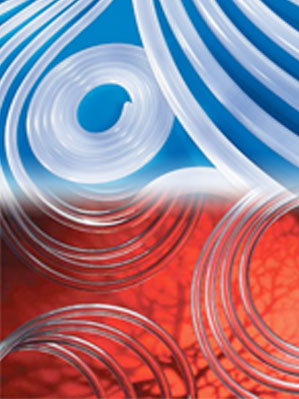Elastomers
Elastomers are a category of pliable plastic material that are good at insulating, withstanding deformation, and molding into different shapes. As a particular kind of polymer, elastomers include natural and artificial rubber. We find elastomers in a wide variety of applications, from the wheels on a skateboard and the soles of tennis shoes, to the insulation covering speaker cables and telephone lines.

- History
- Properties
- Applications
- Processes
- Recycling
- Faq
History
The first common elastomer was natural rubber. Formed in a living organism, it consists of solids suspended in a milky fluid, called latex, that circulates in the inner portions of the bark of many tropical and subtropical trees and shrubs.
Today, natural rubber constitutes only about a fourth of the rubber on the market; the rest is rubber that is produced synthetically by means of chemical processes that were partly known in the 19th century but were not applied commercially until the second half of the 20th century, after World War II.
Both natural and synthetic rubber are produced as latex or as a rough, dried material that is packed into bales for shipping to the products fabricator. In order to be made into useful products, these raw polymers must be greatly modified by a number of additives.
Properties
These unique polymers offer many unique properties:
- they are easy to sculpt when they are in their softened, resinous state
- Yet once they harden, they remain impervious to changes in most changes in temperature as well as stress like stretching or compressing
In addition, they are:
- very strong when struck
- hard if scratched
- resistant to corrosion from various chemicals
- resilient in the face of humidity or water submersion
- Since they don't conduct current, they are good electronic insulators. Between different branches of wires, they are dense and protective.
Another beneficial property is that they can be "compounded" or joined with other materials to strengthen certain characteristics. Other kinds of polymers may make them less likely to soften at high temperatures or break down around ozone gas. Elastomers can easily be installed next to various other materials, such as metal, hard plastic, or different kinds of rubber, with excellent adherence.
Applications
Elastomers are useful and diverse substances that easily form various rubbery shapes.
Many industries rely on parts made from elastomers, especially:
- automobiles
- sports
- electronics
- assembly line factories
Processes
The manufacture of elastomers and elastomer products consists generally of the following steps:
- preparation of a formula and selection of raw materials;
- compounding;
- shaping and vulcanization.
Shaping can take the form of pressing, injection molding, calendering or extruding at the vulcanization temperature, which is approximately in the 150 to 200°C range.
Recycling
The problem as regards recycling is that elastomers, as chemically crosslinked polymers, are not fusible and do not allow for reshaping. In this way, they differ significantly from plastics.
Current state of the art is the blending of shredded scrap rubber into new rubber matrices, whereby – admittedly – the physical properties suffer greatly. This explains endeavors and developments in the direction of devulcanization processes.
